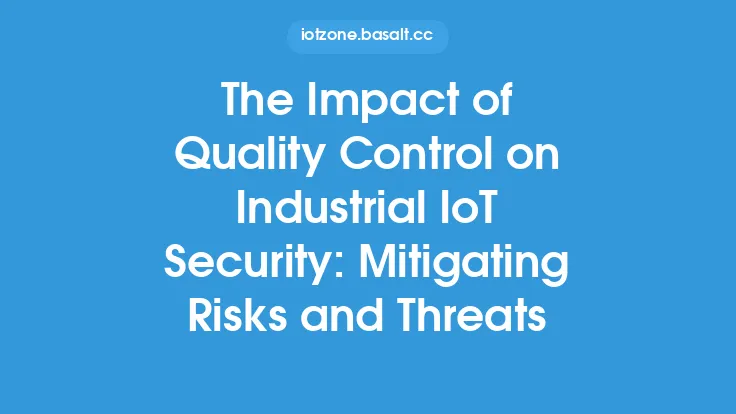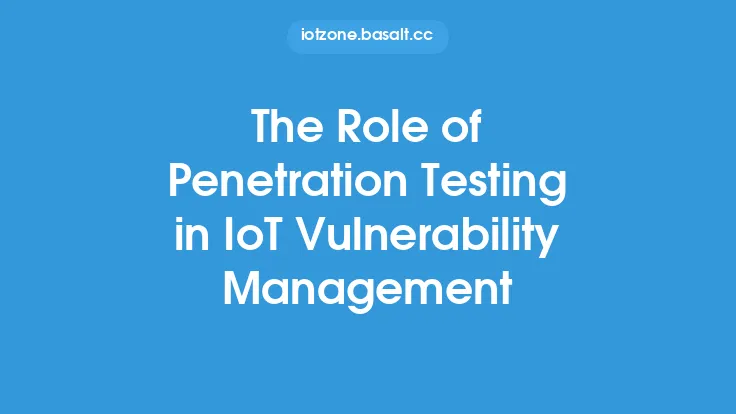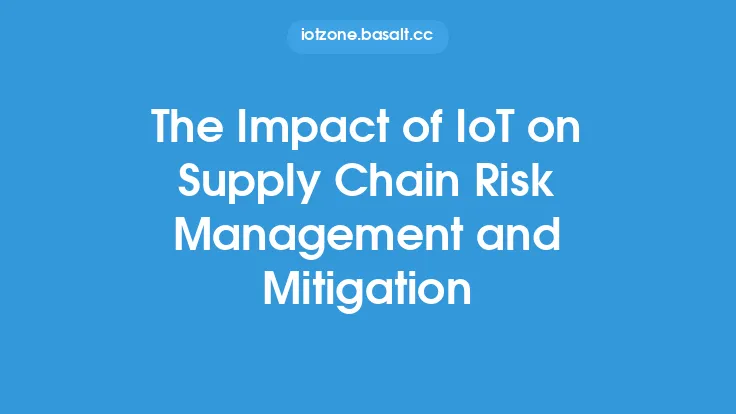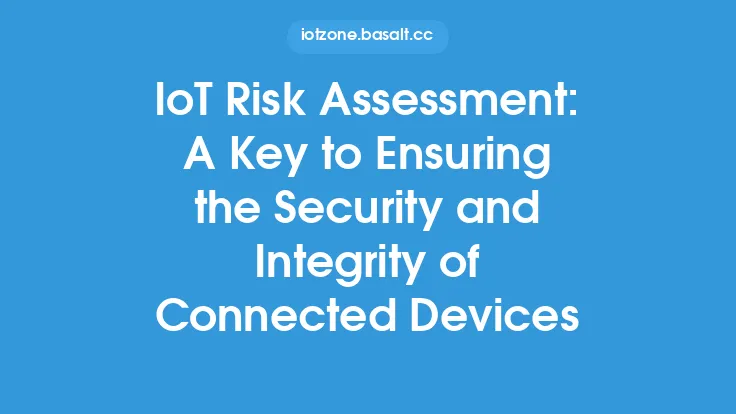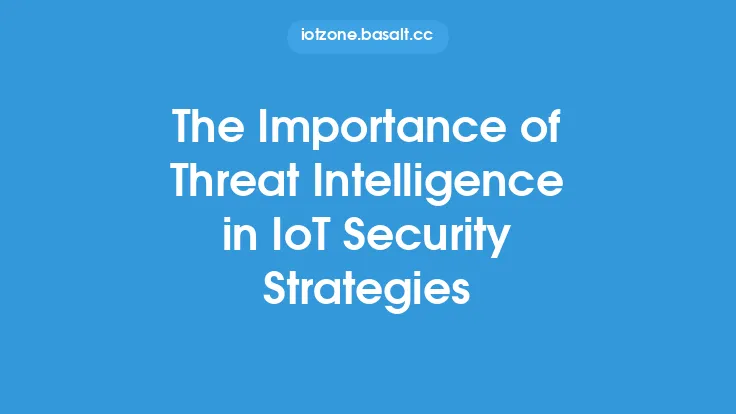The increasing number of Internet of Things (IoT) devices has led to a significant rise in the attack surface, making it challenging for organizations to maintain a robust security posture. One crucial aspect of IoT security is vulnerability management, which involves identifying, classifying, prioritizing, and remediating vulnerabilities in IoT devices and systems. Effective vulnerability management is essential to prevent cyber attacks, protect sensitive data, and ensure the overall security and integrity of IoT ecosystems.
Introduction to Vulnerability Management in IoT
Vulnerability management in IoT involves a comprehensive approach to identifying and addressing vulnerabilities in IoT devices, networks, and systems. This includes conducting regular vulnerability assessments, prioritizing vulnerabilities based on their severity and potential impact, and implementing remediation strategies to mitigate or eliminate vulnerabilities. The goal of vulnerability management is to reduce the risk of cyber attacks and protect IoT devices and systems from exploitation by attackers.
The Impact of Vulnerability Management on IoT Security Posture
Effective vulnerability management has a significant impact on the security posture of IoT devices and systems. By identifying and addressing vulnerabilities, organizations can prevent cyber attacks, reduce the risk of data breaches, and protect sensitive information. Vulnerability management also helps to ensure compliance with regulatory requirements and industry standards, reducing the risk of non-compliance and associated penalties. Furthermore, vulnerability management enables organizations to improve their incident response capabilities, reducing the time and cost associated with responding to and recovering from cyber attacks.
Key Components of Vulnerability Management in IoT
Several key components are essential to effective vulnerability management in IoT, including:
- Vulnerability Identification: This involves using various tools and techniques, such as vulnerability scanning and penetration testing, to identify vulnerabilities in IoT devices and systems.
- Vulnerability Classification: This involves categorizing vulnerabilities based on their severity, potential impact, and other factors to prioritize remediation efforts.
- Vulnerability Prioritization: This involves prioritizing vulnerabilities based on their severity, potential impact, and other factors to ensure that the most critical vulnerabilities are addressed first.
- Remediation: This involves implementing strategies to mitigate or eliminate vulnerabilities, such as patching, configuration changes, or replacing vulnerable components.
- Monitoring and Maintenance: This involves continuously monitoring IoT devices and systems for new vulnerabilities and maintaining up-to-date vulnerability management processes and procedures.
Technical Aspects of Vulnerability Management in IoT
From a technical perspective, vulnerability management in IoT involves several key aspects, including:
- Network Segmentation: This involves segmenting IoT networks to isolate vulnerable devices and prevent lateral movement in the event of a breach.
- Encryption: This involves using encryption to protect data in transit and at rest, reducing the risk of data breaches and unauthorized access.
- Secure Coding Practices: This involves using secure coding practices, such as secure coding guidelines and code reviews, to prevent vulnerabilities in IoT software and firmware.
- Firmware and Software Updates: This involves regularly updating firmware and software to ensure that IoT devices and systems have the latest security patches and updates.
- Intrusion Detection and Prevention Systems: This involves using intrusion detection and prevention systems to detect and prevent cyber attacks on IoT devices and systems.
Benefits of Effective Vulnerability Management in IoT
Effective vulnerability management in IoT offers several benefits, including:
- Improved Security Posture: Vulnerability management helps to reduce the risk of cyber attacks and protect IoT devices and systems from exploitation.
- Compliance: Vulnerability management helps to ensure compliance with regulatory requirements and industry standards, reducing the risk of non-compliance and associated penalties.
- Reduced Risk: Vulnerability management helps to reduce the risk of data breaches, unauthorized access, and other cyber threats.
- Improved Incident Response: Vulnerability management enables organizations to improve their incident response capabilities, reducing the time and cost associated with responding to and recovering from cyber attacks.
- Cost Savings: Vulnerability management helps to reduce the cost associated with responding to and recovering from cyber attacks, as well as the cost of non-compliance and associated penalties.
Challenges and Limitations of Vulnerability Management in IoT
Despite the importance of vulnerability management in IoT, several challenges and limitations exist, including:
- Complexity: IoT ecosystems are often complex and heterogeneous, making it challenging to identify and address vulnerabilities.
- Limited Resources: Small and medium-sized organizations may have limited resources, making it challenging to implement and maintain effective vulnerability management processes and procedures.
- Evolving Threat Landscape: The threat landscape is constantly evolving, making it challenging to stay ahead of emerging threats and vulnerabilities.
- Lack of Standardization: IoT devices and systems often lack standardization, making it challenging to develop and implement effective vulnerability management processes and procedures.
- Limited Visibility: IoT devices and systems often have limited visibility, making it challenging to detect and respond to cyber attacks.
Best Practices for Implementing Vulnerability Management in IoT
To implement effective vulnerability management in IoT, several best practices should be followed, including:
- Conduct Regular Vulnerability Assessments: Regular vulnerability assessments should be conducted to identify vulnerabilities in IoT devices and systems.
- Prioritize Vulnerabilities: Vulnerabilities should be prioritized based on their severity, potential impact, and other factors to ensure that the most critical vulnerabilities are addressed first.
- Implement Remediation Strategies: Remediation strategies should be implemented to mitigate or eliminate vulnerabilities, such as patching, configuration changes, or replacing vulnerable components.
- Continuously Monitor and Maintain: IoT devices and systems should be continuously monitored and maintained to ensure that vulnerability management processes and procedures are up-to-date and effective.
- Collaborate with Stakeholders: Collaboration with stakeholders, including vendors, suppliers, and industry partners, is essential to ensure that vulnerability management processes and procedures are effective and aligned with industry best practices.
